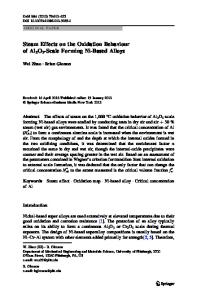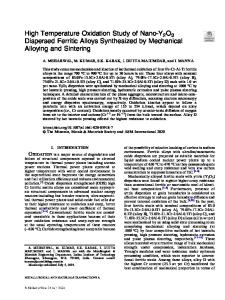The formation of discontinuous Al 2 O 3 layers during high temperature oxidation of IrAl alloys
- PDF / 4,417,145 Bytes
- 7 Pages / 593.28 x 841.68 pts Page_size
- 48 Downloads / 363 Views
Oxidation of IrAl alloys (50-50 at. %) was conducted at 1300 and 1600 °C in air for different times. Due to the outward diffusion of Al atoms and subsequent oxidation, the formation of A12O3 is accompanied with the generation of an Ir-rich phase in the vicinity areas. The oxidation zone is separated from the bulk IrAl alloy by a phase boundary. In the oxidation zones, alternating layers of A12O3 and Ir-rich phase are produced at 1300 °C, while irregularly intertwined A12O3 and Ir-rich phase are produced at 1600 °C. The discontinuous formation of A12O3 gives rise to internal oxidation of the IrAl alloys. The thickness of the A12O3 layer is in the range of tens of micrometer, and it grows thicker as its location gets farther away from the free surface. The formation of an Al2O3/Ir-rich phase layered structure is discussed based on the diffusion kinetics of O, Al, and Ir, the chemical reactivities of Al and Ir with respect to O, and the nucleation and growth kinetics of A12O3.
I. INTRODUCTION
Since the finding of periodic precipitation in gelatinelectrolyte systems by Liesegang,1 a few solid state materials have also been reported to exhibit such a behavior under specific conditions. In gas-solid systems, the periodic precipitation of gaseous precipitates (H2O) was formed2 in oxygen charged single crystals of silver when annealed under hydrogen ambient. A band structure distribution of the CdO particles was produced in the internal oxidized Ag-Cd alloys (9 wt. % Cd)3 containing small amounts of certain additives: Al, Be, Mg, Sc, or Y (generally less than 1 at. %). In solid-solid systems, by solid state interdiffusion, the periodic precipitation of FeSi was formed in the diffusion zone of Fe(15 wt. % Si)/ Zn diffusion couples.4 Periodic bands containing a mixture of FeS and FeAl2S4 were formed in the internal sulfidation zone of FeS/Fe (6, 9, 18, and 28 at. % Al) diffusion couples.5 Recently, periodic precipitation of carbon was observed during the solid state reaction in the Pt/SiC diffusion couples.6 Several theories have been proposed to explain the mechanism of periodic precipitation in either gelatinelectrolyte or solid state systems. These theories have been restricted7 primarily to those cases where the outer reactant reacts with only one component of an initially homogeneous solution. A quantitative theory has been given by Wagner8 based on the "supersaturation theory" of Ostwald.9 Based on this theory, periodic structures will form7 when the growth rate of the precipitate at the precipitation front is not sufficient to keep up with an inward diffusion of outer reactant. More outer reactant arrives at the precipitation front than is consumed by the inner reactant; when the product of the concentrations of the components exceeds a critical value (the 378
http://journals.cambridge.org
J. Mater. Res., Vol. 5, No. 2, Feb 1990
Downloaded: 14 Mar 2015
supersaturation product), new precipitates start to nucleate in front of the existing precipitate. Once the new precipitates are formed the concentration product
Data Loading...











